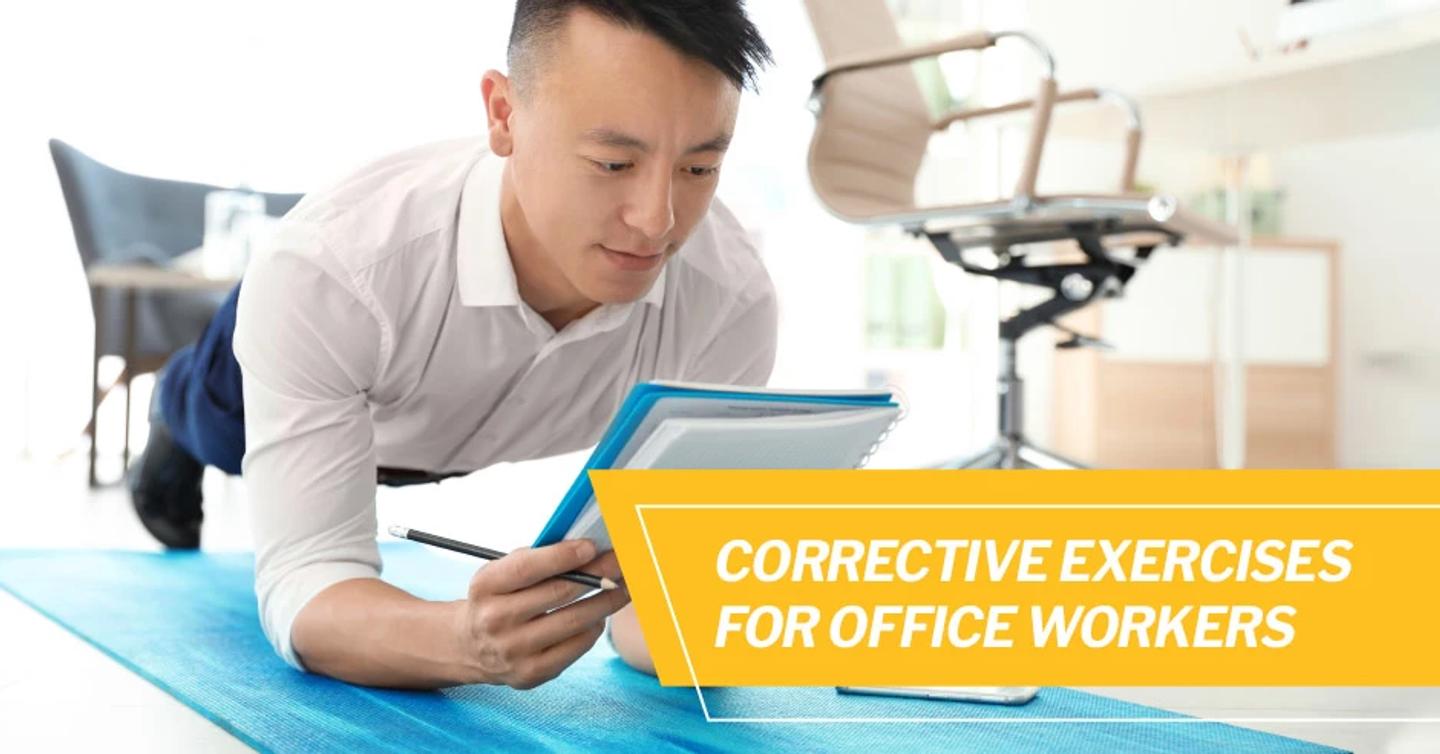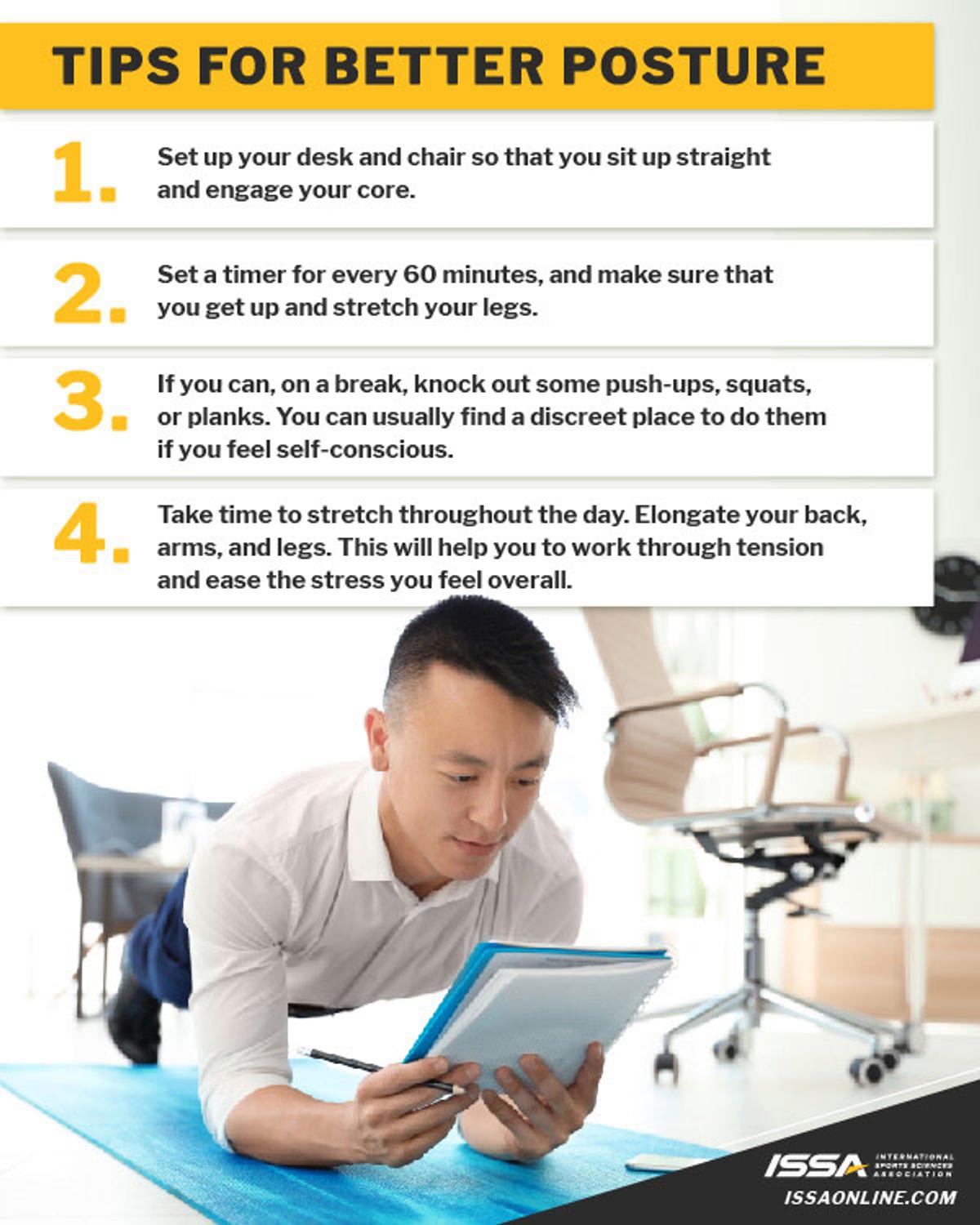
Corrective Exercises for Office Workers
Reading Time: 5 minutes 45 seconds
BY: ISSA
DATE: 2019-07-19
As personal trainers, we are fortunate to work in an occupation that allows us to be active, on our feet, and moving throughout the day. However, many of our clients aren't so lucky. Not to say that there's anything wrong or negative at all about an office workplace environment, but there are some bad habits that can form while working at a desk all day every day.
There are some common health issues for men and women that can develop over time. Usually, these surround things like sitting down all day, lack of movement, poor posture, etc., and can have adverse effects which compound themselves over time. And we can revise our approach to work-life balance all we want, but at the end of the day, we're still going to spend the majority of our weeks at work—even if it's remote work!
This tends to be common among white-collar workers especially, facing their own occupational health and occupational safety issues. In nature, they are primarily repetitive use and stress injuries that develop, such as neck pain, carpal tunnel syndrome, pain in the shoulders and shoulder blades, and all sorts of musculoskeletal disorders.
Suffice it to say, there are plenty of work-related injuries that office workers can experience. The good news is that they have you on their side. With your knowledge and expertise, you can develop programming to help prevent these conditions from developing. Or, if a few of them have already started developing in your clients, you can develop effective programming to nip the problem in the bud before it becomes debilitating. So, let's take a look at common movement issues for office workers and talk about how to fix them.
Safety First — And Foremost
When it comes to your clients, remember that preventing injury while exercising is your highest responsibility. This is why you put together their program, why you should know what they're doing on their off days, and why you should be available to help them out from time to time when they have questions about the kinesiology behind movements, so that they don't risk getting hurt.
Whereas you can and should be an early warning indicator for deeper issues, personal trainers are not medical professionals like doctors or physical therapists. So, make sure your client visits their doctor if they are hurt or run into issues with particular motions. You can absolutely train the client within the bounds of what their doctor says, but do not try to diagnose anything yourself.
If there is something deeper, like a repetitive use injury, or something resulting from poor posture, you could make it so much worse. So just be careful when working with your clients to ensure that they aren't already injured. The advice in this article is mainly surrounding how to prevent these issues and how to deal with minor issues, but this is not medical advice. If your client is in pain, they need to seek out professional medical counsel. This is how you can best look out for their health and well-being, not to mention helping them avoid the headache of a worker's compensation claim!
Putting Together the Program
When it comes to the question of how to design a corrective exercise program for office workers, it's best to treat it like any other issue—start from the source. Are they lacking in good posture? Are they sitting too long without getting up? Are they leaning on one leg for too long when standing? Does their back hunch when working at their desk?
Most people at some point in their lives will have a problem that can be traced back to too much sitting or standing at work. It might sound like something incredibly small, but the small things really start to add up after a while.
There are so many different possible issues that can arise. Fortunately, you are there to save the day. So, let's go into a few exercises that will allow you to really piece together solutions based on the problems your client is experiencing.
1. Planks
Without a doubt, this is one of the bigger catch-all exercises that will help with a good many issues that office workers find themselves in. By targeting the core, you are targeting the area of the body responsible for posture to begin with. So many issues that office workers face deal with a lack of core strength. But planks do more than simply work the core.
Planks end up using most of the body's muscles, if even only as support. For instance, think about the ligaments and musculature surrounding your feet, your shoulders, your chest, and so on, as you maintain the plank position. All of this will help your clients to undo some of the damage from all that slouching.
2. Rows
Rowing sets are fantastic for strengthening the muscles in the back. Many people overlook the back in their workout regimens. One of the most reported issues with office work is back pain. Ensuring that you have developed your client's back muscles is one of the best ways to prevent further degradation from all of that sitting.
Rows can take many different forms. The truth is that most of them will be beneficial for this purpose. Whether it's the rowing weight machine, bent-over rows, dumbbell rows, whatever! The key is that you incorporate an exercise like this into the rest of your programming, so let that determine the specific type of rows that you recommend.
And, while you're at it, don't just stop at resistance rows, like what you would do on a weight machine, but also remember that the cardio rower is an amazing way to work the whole body, including the back. Don't be afraid to assign some time on this machine outside of your sessions. It could be a life saver!
3. Sumo Squats
Easily one of the most versatile exercises out there, having squats in your program regularly will be helpful. Squats engage the whole body, especially the core, while focusing on the legs. This is a surefire way to increase lean muscle mass as well as to alleviate tightness in the hips from prolonged sitting. Sumo squats require a wider base which will also more effectively stretch the hips out, killing two birds with one stone.
4. Deadlifts
Deadlifts are one of the better ways to strengthen your lower back and hamstrings. By taking the time to focus specifically on this muscle group, your clients can more effectively bounce back from long periods of sitting at a desk in front of their computers.
But that's not all. By forcing yourself to hold onto the weight, it's also helping your client's shoulders and neck muscles. Be careful that there isn't an existing shoulder injury, as deadlifts can exacerbate these conditions, especially if it's something posture-related.
Happiness & Satisfaction at Work
One of the added mental health benefits of this sort of training is how much better your clients will feel when they're no longer suffering from office-related issues. Suffering all day every day can really take a toll on people, and it will bleed over into other aspects of their lives.
Yes, we train to be healthy, we train to look good, we train for all these physical reasons, but we also train to feel our best. There are plenty of ways that work can be a bummer, and when it also hurts you physically, it compounds the issue. In fact, it can even cause cycles of depression. So, by helping your clients train to prevent these types of situations from office work, you are also helping to improve their happiness.
Having a healthier body can even help with progress at work. The confidence that comes from increased exercise combined with less pain and irritation can really be a game changer. This is why you need to take these concerns seriously. It's one of the many points in which a personal trainer can make all the difference in the life of a client. And that's a pretty special thing.
Learning More
ISSA has an entire curriculum surrounding corrective exercise—and even offers a specialist certification on the subject! If you would like to know more about how you can become a Corrective Exercise Specialist through ISSA, then just click here to find out how.

Click HERE to download this handout and share with your clients!